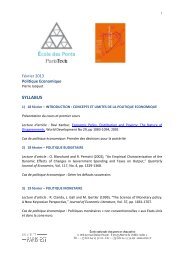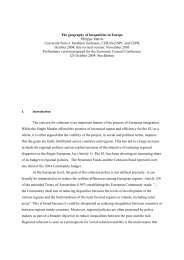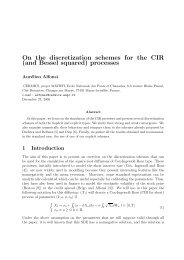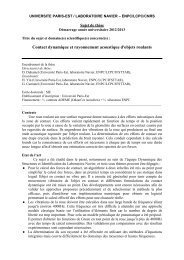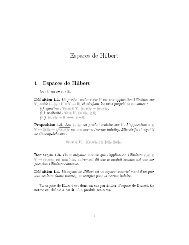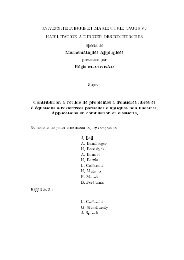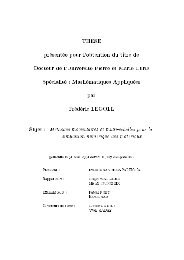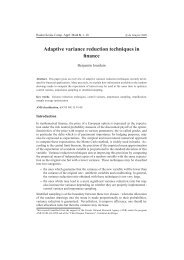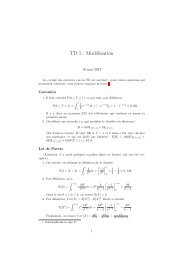Create successful ePaper yourself
Turn your PDF publications into a flip-book with our unique Google optimized e-Paper software.
30 Chapitre 2 : Analyse numérique dans un cas simplié<br />
Proof. Without loss of generality, we assume that the diagonal elements of H i<br />
are strictly separated :<br />
ɛ i1 < ɛ i2 < . . . < ɛ in<br />
for i = 1, 2. If some of the diagonal elements were equal, then we could establish the<br />
corollary by considering a sequence of perturbed problems and letting the perturbation<br />
go to zero. By the rst-order optimality conditions (2.8) and by the diagonal<br />
structure of the H i , we have<br />
(ɛ 1j − λ 1 )y 1j = µy 2j and (ɛ 2j − λ 2 )y 2j = µy 1j .<br />
We combine these equations to obtain<br />
]<br />
]<br />
[(ɛ 1j − λ 1 )(ɛ 2j − λ 2 ) − µ 2 y 1j = 0 =<br />
[(ɛ 1j − λ 1 )(ɛ 2j − λ 2 ) − µ 2 y 2j . (2.36)<br />
By Corollary 1, the multipliers λ 1 and λ 2 satisfy λ i ∈ [ɛ i1 , ɛ i2 ]. Hence, the coecient<br />
of y 1j and y 2j in (2.36) are strictly increasing functions of j ∈ [2, n]. It<br />
follows that these coecients can vanish for at most one j ∈ [2, n] and possibly for<br />
j = 1. When the coecients of y 1j and y 2j do not vanish in (2.36), we must have<br />
y 1j = y 2j = 0. In summary, at the global optimum, all the components of y ij vanish<br />
except possibly y 11 , y 21 , y 1j , and y 2j for some j ∈ [2, n]. We focus on the case j = 2<br />
since j > 2 leads to a larger cost.<br />
Dene x 2 1j = v j and x 2 2j = w j for j = 1, 2. The optimization problem (2.1) with<br />
H i diagonal and x ij = 0 for j > 2 reduces to<br />
min v 1 ɛ 11 + v 2 ɛ 12 + w 1 ɛ 21 + w 2 ɛ 22<br />
subject to v 1 + v 2 = 1 = w 1 + w 2 ,<br />
v 1 w 1 = v 2 w 2 , v 1 , v 2 , w 1 , w 2 ≥ 0.<br />
The equation v 1 w 1 = v 2 w 2 is the orthogonality condition x 11 x 21 = −x 12 x 22 squared.<br />
We substitute v 1 = 1 − v 2 and w 1 = 1 − w 2 to reduce the optimization problem to<br />
min ɛ 11 + ɛ 21 + v 2 (ɛ 12 − ɛ 11 ) + w 2 (ɛ 22 − ɛ 21 ) (2.37)<br />
subject to v 2 + w 2 = 1, v 2 ≥ 0, w 2 ≥ 0.<br />
We substitute v 2 = 1−w 2 in the objective function to further reduce the optimization<br />
problem to<br />
min ɛ 21 + ɛ 12 + w 2 (ɛ 11 + ɛ 22 − ɛ 21 − ɛ 12 )<br />
subject to 0 ≤ w 2 ≤ 1.<br />
Since the cost function is linear in w 2 , the minimum is achieved at either w 2 = 0<br />
(w 1 = 1, v 1 = 0, v 2 = 1) with objective function value ɛ 21 + ɛ 12 or w 1 = 1 (w 2 = 0,<br />
v 1 = 1, v 2 = 0) with objective function value ɛ 11 + ɛ 22 .



